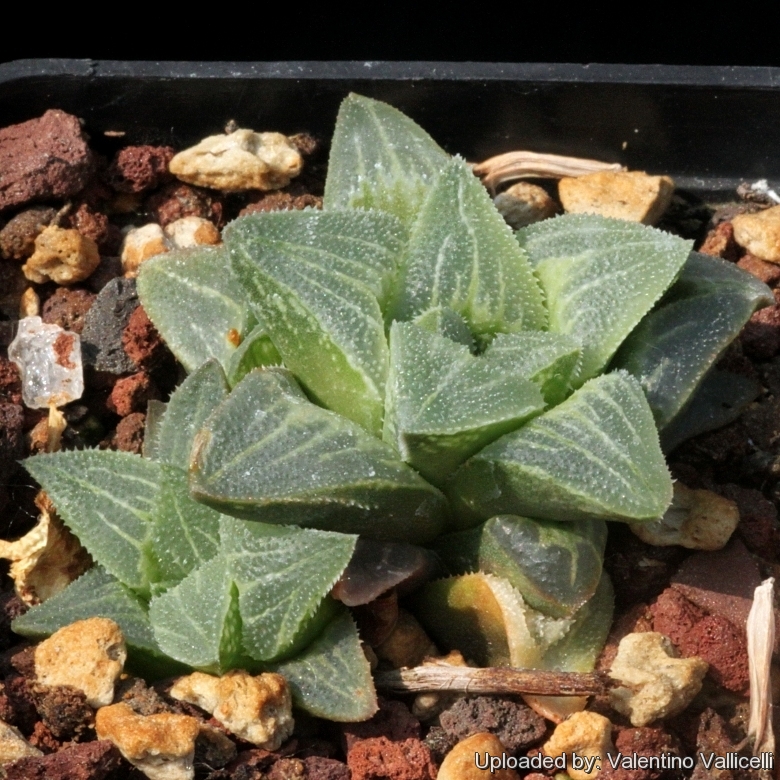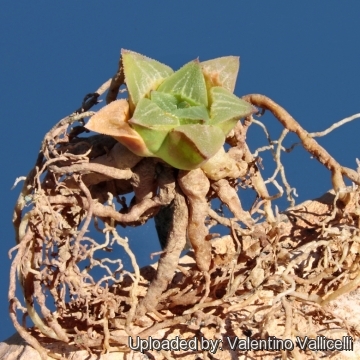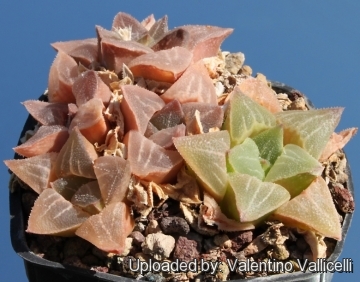
Haworthia pygmaea Photo by: Valentino Vallicelli
CC2726 (A plant from Cocozza Collection Joyce L. Cocozza. As EM-7 ex Witch Hazel Gardens, JAPAN, received from VA 4191 ex CG on 11/10/1997.)
Origin and Habitat: It is found in a small area around Great Brak and Mossel Bay in Eastern Cape.
Habitat: In nature it occurs on rocky quartz outcrops often among grasses near to Haworthia parksianaSN|16777]]SN|22535]] and Haworthia kingianaSN|26189]]SN|26189]]. To the West it is connected with the var. argenteo-maculosa. Intermediate forms with Haworthia turgidaSN|22535]]SN|16777]] has been reported at West of Herbetsdale.
Synonyms:
See all synonyms of Haworthia pygmaea
Description: It is a small proliferating species forming flattened groups about 6-10 cm in diameter (but often larger in cultivation) The name "pygmaea" refers to small size, but Haworthia pygmaeaSN|16750]]SN|16750]] has similar size as other species.
Stem: Stemless.
Rosettes: Usually only 3 cm in diameter with about 10 to15 leaves.
Leaves: 2,5-3 cm long (or a little more in cultivation) and up to1, 8 cm wide, glossy dark green or olive green often shaded of pink with cold weather, retused, narrowly oval, the leaf-end areas are flattish and the leaf-tips rounded-triangular; leaf surfaces pellucid scabrid or papillate with raised tubercles, occasionally very papillose with 4-5 pale longitudinal lines; margin smooth; keeled beneath.
Inflorescences: Up to 30 cm tall, robust.
Flowers: About 15 to 20 white with greenish veins.
Subspecies, varieties, forms and cultivars of plants belonging to the Haworthia pygmaea pygmaea
 Haworthia pygmaea Photo by: Valentino Vallicelli
Haworthia pygmaea Photo by: Valentino Vallicelli Haworthia pygmaea Photo by: Valentino Vallicelli
Haworthia pygmaea Photo by: Valentino VallicelliCultivation and Propagation: Haworthia pygmaeaSN|16750]]SN|16750]] is a slowly proliferous species.
Soil: Give the plant an airy growing medium which mainly consists of non organic material such us clay, pumice, lava grit, and only a little peat or leaf-mould. Needs a deep pot to accommodate the long, thick, contractile roots.
Watering needs: It needs regular water, but do not water again until dry. Also, it is a species that is dormant in the winter and requires very little water (maybe even none) during the cold months.
Frost Tolerance: Light frost protection required. Minimum of 5º C for safe growing (but hardy up to -5° C or less.)
Sun Exposure: Requires light shade to bright light (protect from strong midday sun). In shade the body colour will remain mostly green, while full sun will darken and give it a rich pink-red body colour. Can be sunburned if moved from shade/greenhouse into full sun too quickly. The amount of sunlight it can withstand without scorching depends upon the how hot it becomes in the summer in the location in which it is planted. It will have more colour if it receives more light. During the spring it may be able to take full sun until the heat arrives at the end of spring. In an area that has hot afternoon sun, it may be able to take full morning sun, but requires afternoon shade or afternoon light shade.
Propagation: It is easy to propagate by seed or by offsets that appear at the base between the leaves; leave the offsets attached to form a cluster, or wait until they are 1/3 the size of the parent and then detach and plant.












